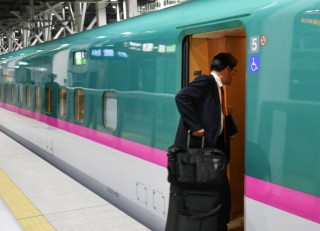Loading
Search
▼ Most Seats Empty On Hokkaido Shinkansen
- Category:Other
Slightly more people have been riding the new Hokkaido Shinkansen Line than expected, but not enough to avoid losses, according to the bullet train’s operator.
The line, which opened March 26, saw average seat occupancy of 27 percent in its first 16 days, JR Hokkaido Co. President Osamu Shimada said Wednesday.
This was marginally above JR Hokkaido’s expectation of 25 percent.
“Tour products are attracting solid demand,” Shimada told a news conference, though he did not evaluate the occupancy rate as good or bad.
Based on the 25 percent forecast, JR Hokkaido projects an annual loss of ¥4.8 billion from Hokkaido Shinkansen operations over the next three years.
The operator has said it expects profitability to remain tough until fiscal 2030, when the line reaches Sapporo, Hokkaido’s largest city.
Trains were 61 percent full on the line’s first day of service, but this fell to 37 percent on the second day and 31 percent on the third day.
After that, the occupancy rate consistently stayed below 30 percent, except on April 3, the second Sunday after the opening, when the rate reached 30 percent. During the three days through Friday, it sank below 20 percent.
The average daily number of passengers on Hokkaido bullet trains reached about 5,700 for the first 16 days, 2.2 times that for conventional trains a year earlier.
For the Golden Week holiday period between April 28 and May 8, less than 30 percent of the seats available for reservations were booked as of Sunday.
“We are watching the situation,” Shimada said.
The shinkansen cuts the travel time from the port city of Hakodate to Tokyo by 53 minutes compared with the previous shortest rail travel time.
The line, which opened March 26, saw average seat occupancy of 27 percent in its first 16 days, JR Hokkaido Co. President Osamu Shimada said Wednesday.
This was marginally above JR Hokkaido’s expectation of 25 percent.
“Tour products are attracting solid demand,” Shimada told a news conference, though he did not evaluate the occupancy rate as good or bad.
Based on the 25 percent forecast, JR Hokkaido projects an annual loss of ¥4.8 billion from Hokkaido Shinkansen operations over the next three years.
The operator has said it expects profitability to remain tough until fiscal 2030, when the line reaches Sapporo, Hokkaido’s largest city.
Trains were 61 percent full on the line’s first day of service, but this fell to 37 percent on the second day and 31 percent on the third day.
After that, the occupancy rate consistently stayed below 30 percent, except on April 3, the second Sunday after the opening, when the rate reached 30 percent. During the three days through Friday, it sank below 20 percent.
The average daily number of passengers on Hokkaido bullet trains reached about 5,700 for the first 16 days, 2.2 times that for conventional trains a year earlier.
For the Golden Week holiday period between April 28 and May 8, less than 30 percent of the seats available for reservations were booked as of Sunday.
“We are watching the situation,” Shimada said.
The shinkansen cuts the travel time from the port city of Hakodate to Tokyo by 53 minutes compared with the previous shortest rail travel time.
- April 16, 2016
- Comment (0)
- Trackback(0)


